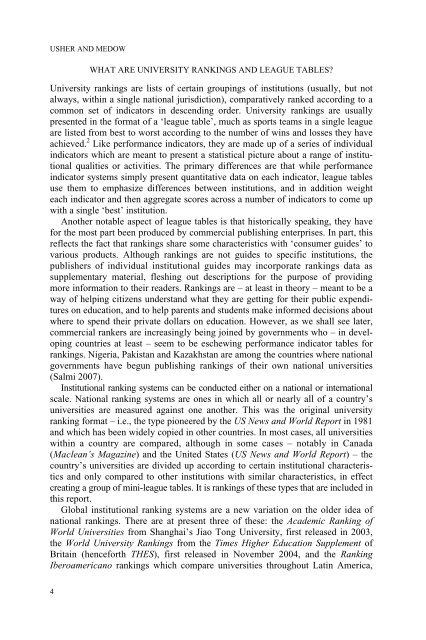University Rankings, Diversity, and the New ... - Sense Publishers
University Rankings, Diversity, and the New ... - Sense Publishers
University Rankings, Diversity, and the New ... - Sense Publishers
You also want an ePaper? Increase the reach of your titles
YUMPU automatically turns print PDFs into web optimized ePapers that Google loves.
USHER AND MEDOW<br />
WHAT ARE UNIVERSITY RANKINGS AND LEAGUE TABLES?<br />
<strong>University</strong> rankings are lists of certain groupings of institutions (usually, but not<br />
always, within a single national jurisdiction), comparatively ranked according to a<br />
common set of indicators in descending order. <strong>University</strong> rankings are usually<br />
presented in <strong>the</strong> format of a ‘league table’, much as sports teams in a single league<br />
are listed from best to worst according to <strong>the</strong> number of wins <strong>and</strong> losses <strong>the</strong>y have<br />
achieved. 2 Like performance indicators, <strong>the</strong>y are made up of a series of individual<br />
indicators which are meant to present a statistical picture about a range of institutional<br />
qualities or activities. The primary differences are that while performance<br />
indicator systems simply present quantitative data on each indicator, league tables<br />
use <strong>the</strong>m to emphasize differences between institutions, <strong>and</strong> in addition weight<br />
each indicator <strong>and</strong> <strong>the</strong>n aggregate scores across a number of indicators to come up<br />
with a single ‘best’ institution.<br />
Ano<strong>the</strong>r notable aspect of league tables is that historically speaking, <strong>the</strong>y have<br />
for <strong>the</strong> most part been produced by commercial publishing enterprises. In part, this<br />
reflects <strong>the</strong> fact that rankings share some characteristics with ‘consumer guides’ to<br />
various products. Although rankings are not guides to specific institutions, <strong>the</strong><br />
publishers of individual institutional guides may incorporate rankings data as<br />
supplementary material, fleshing out descriptions for <strong>the</strong> purpose of providing<br />
more information to <strong>the</strong>ir readers. <strong>Rankings</strong> are – at least in <strong>the</strong>ory – meant to be a<br />
way of helping citizens underst<strong>and</strong> what <strong>the</strong>y are getting for <strong>the</strong>ir public expenditures<br />
on education, <strong>and</strong> to help parents <strong>and</strong> students make informed decisions about<br />
where to spend <strong>the</strong>ir private dollars on education. However, as we shall see later,<br />
commercial rankers are increasingly being joined by governments who – in developing<br />
countries at least – seem to be eschewing performance indicator tables for<br />
rankings. Nigeria, Pakistan <strong>and</strong> Kazakhstan are among <strong>the</strong> countries where national<br />
governments have begun publishing rankings of <strong>the</strong>ir own national universities<br />
(Salmi 2007).<br />
Institutional ranking systems can be conducted ei<strong>the</strong>r on a national or international<br />
scale. National ranking systems are ones in which all or nearly all of a country’s<br />
universities are measured against one ano<strong>the</strong>r. This was <strong>the</strong> original university<br />
ranking format – i.e., <strong>the</strong> type pioneered by <strong>the</strong> US <strong>New</strong>s <strong>and</strong> World Report in 1981<br />
<strong>and</strong> which has been widely copied in o<strong>the</strong>r countries. In most cases, all universities<br />
within a country are compared, although in some cases – notably in Canada<br />
(Maclean’s Magazine) <strong>and</strong> <strong>the</strong> United States (US <strong>New</strong>s <strong>and</strong> World Report) – <strong>the</strong><br />
country’s universities are divided up according to certain institutional characteristics<br />
<strong>and</strong> only compared to o<strong>the</strong>r institutions with similar characteristics, in effect<br />
creating a group of mini-league tables. It is rankings of <strong>the</strong>se types that are included in<br />
this report.<br />
Global institutional ranking systems are a new variation on <strong>the</strong> older idea of<br />
national rankings. There are at present three of <strong>the</strong>se: <strong>the</strong> Academic Ranking of<br />
World Universities from Shanghai’s Jiao Tong <strong>University</strong>, first released in 2003,<br />
<strong>the</strong> World <strong>University</strong> <strong>Rankings</strong> from <strong>the</strong> Times Higher Education Supplement of<br />
Britain (henceforth THES), first released in November 2004, <strong>and</strong> <strong>the</strong> Ranking<br />
Iberoamericano rankings which compare universities throughout Latin America,<br />
4














